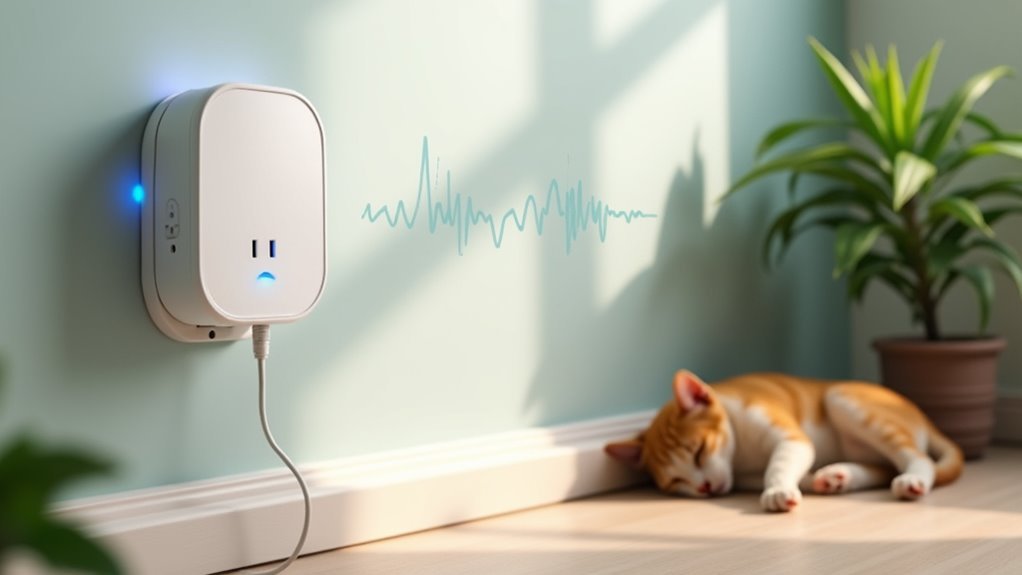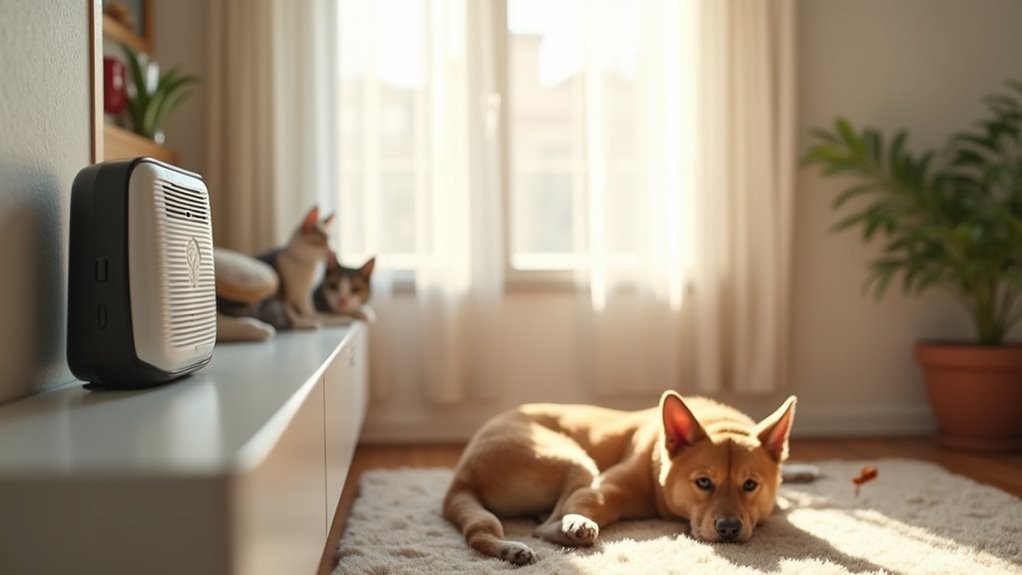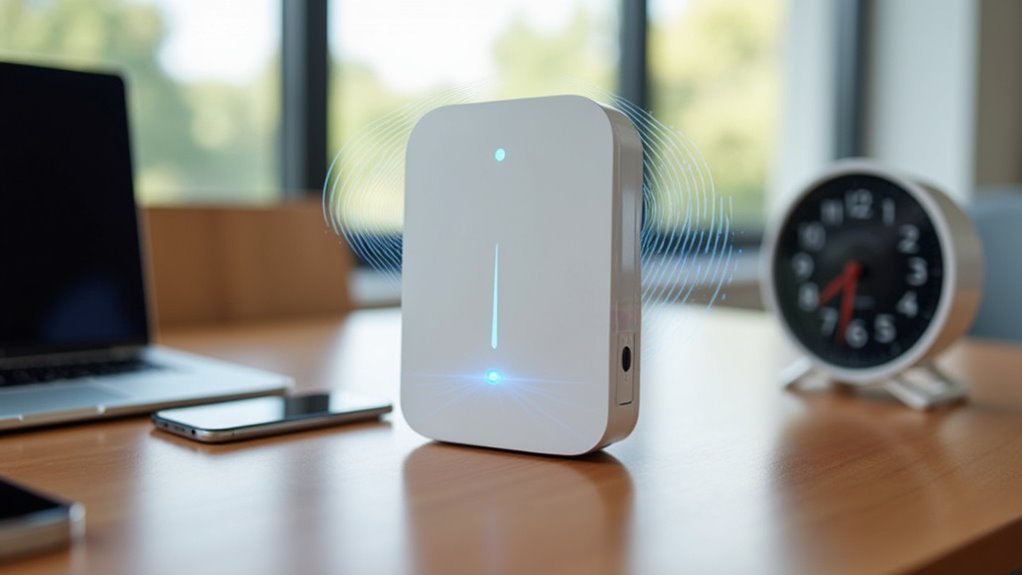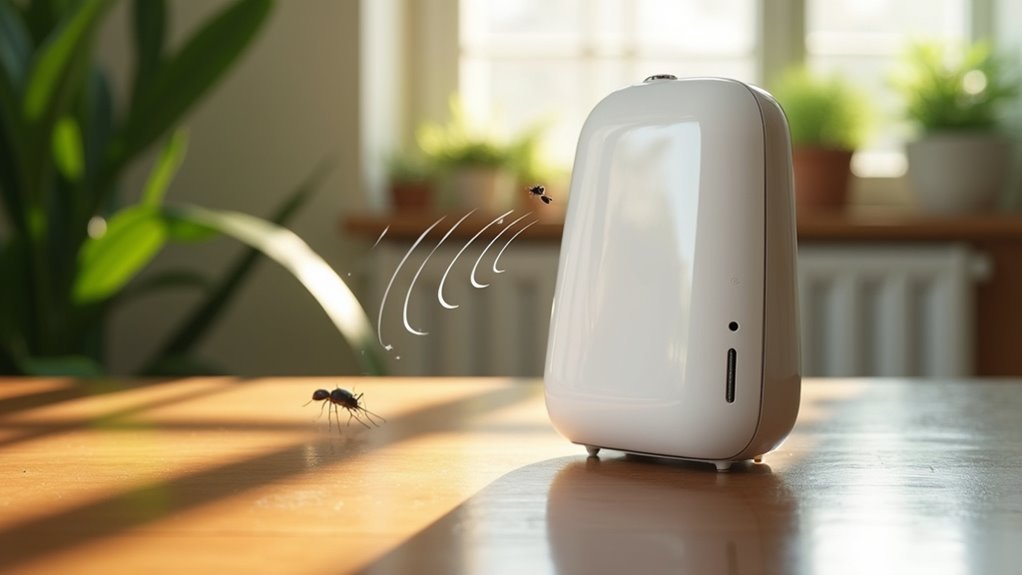You can trust ultrasonic pest repellers because they’re chemical-free devices that emit high-frequency sounds above 20 kHz, which are completely inaudible to humans. They won’t release toxic substances into your home’s air or cause respiratory issues like traditional pesticides. Most pets, including cats and dogs, aren’t affected by these frequencies, though you should monitor smaller pets like hamsters. When properly installed with certified electrical standards, they provide continuous pest deterrence without compromising your family’s health or creating environmental contamination like chemical alternatives would.
Understanding How Ultrasonic Pest Repellers Function

Before you can evaluate whether ultrasonic pest repellers are safe for your home, you’ll need to understand how these devices actually work.
These pest control methods operate by emitting high-frequency sounds above 20 kHz that remain inaudible to humans but target specific pests. When you plug these devices into electrical outlets, they create sound waves designed to cause discomfort in unwanted creatures.
Ultrasonic pest repellers emit high-frequency sounds above 20 kHz that target pests while remaining completely inaudible to humans.
The high-frequency sounds trigger physiological responses in pests, including confusion and distress that disrupts their feeding and breeding patterns.
You’ll find variations include electromagnetic and subsonic options targeting different pest types. However, your device’s effectiveness depends on environmental factors like room size, furniture placement, and sound-absorbing materials that can limit the reach of emitted frequencies throughout your space.
Chemical-Free Operation Benefits
You’ll appreciate that ultrasonic pest repellers don’t release any toxic chemicals into your living space, making them a safer choice for your family’s health.
These devices keep your indoor air quality clean since they work entirely through sound frequencies rather than harmful substances.
You can confidently use them around your pets without worrying about chemical exposure that traditional pesticides often cause.
No Toxic Chemicals
Unlike traditional pest control methods that rely on harmful chemicals, ultrasonic pest repellers offer a completely toxin-free solution that protects your family’s health.
With no toxic chemicals involved, you’ll eliminate the risk of respiratory problems and skin irritations that often accompany pesticide exposure. These devices are safe for humans because they don’t release any chemical odors or leave harmful residues in your living spaces.
You’re also making an environmentally friendly choice that reduces ecological impact.
Without traps or poisons, there’s no risk of accidental ingestion by children, pets, or beneficial insects. Your home stays clean and safe while effectively deterring pests.
This chemical-free approach gives you peace of mind knowing you’re protecting both your family and the environment.
Safe Indoor Air
Chemical-free operation means ultrasonic pest repellers won’t compromise your indoor air quality or create the stuffy, chemical-laden atmosphere that traditional pest control methods often produce.
You’ll breathe easier knowing these devices maintain safe indoor air without releasing toxic fumes or particles into your living space.
Unlike chemical pesticides that can linger in your home’s air circulation system for weeks, ultrasonic pest repellers emit only sound waves that remain completely undetectable to your senses.
You won’t experience headaches, respiratory irritation, or that overwhelming chemical smell that forces you to ventilate your home after pest treatments.
This technology particularly benefits households with family members who suffer from asthma, allergies, or chemical sensitivities, allowing you to address pest problems without sacrificing air quality.
Pet-Friendly Alternative Solution
When you’re searching for pest control that won’t endanger your furry family members, ultrasonic pest repellers provide a non-toxic solution that eliminates the risk of accidental poisoning from chemical baits or sprays.
These pet-friendly devices emit high-frequency sound waves that target pests without affecting most household pets like dogs and cats. You won’t need to worry about your pets ingesting harmful substances or suffering from toxic exposure.
However, you should consider that smaller pets such as hamsters or rabbits might react negatively to the ultrasonic frequencies.
The silent operation means your daily routine remains undisturbed while maintaining an eco-friendly environment. By choosing ultrasonic repellers, you’re protecting both your pets and non-target species from chemical harm.
Human Safety and Hearing Protection
Since ultrasonic pest repellers operate at frequencies above 20 kHz, they won’t damage your hearing or cause any audible disturbance in your home. These devices prioritize human safety by operating beyond your natural hearing range of 20 Hz to 20 kHz. Unlike traditional methods from a pest control company, ultrasonic sound waves provide chemical-free protection without health risks.
| Frequency Range | Human Impact | Safety Level |
|---|---|---|
| Below 20 Hz | Inaudible | Safe |
| 20 Hz – 20 kHz | Audible range | Safe |
| Above 20 kHz | Ultrasonic/inaudible | Safe |
| 25-40 kHz | Device operation | Safe |
| 40+ kHz | Pest targeting | Safe |
Studies confirm these frequencies cause no physical harm to humans or common pets, making them ideal for continuous indoor use without safety concerns.
Pet Safety Considerations and Precautions

While ultrasonic pest repellers pose no risk to human health, your pets require different safety considerations. Most cats and dogs won’t experience issues with ultrasonic sounds since these frequencies typically don’t affect them.
However, you’ll need to exercise caution with small pets like rabbits, guinea pigs, and hamsters, as they’re more sensitive to these high-frequency emissions.
Monitor your pets’ behavior around these devices, watching for signs of distress or anxiety. Position repellers away from small pet habitats and guarantee they’ve retreat spaces if needed.
Since different species react differently to ultrasonic waves, assess each pet’s response individually. If you notice concerning behaviors, consult your veterinarian immediately.
Proper placement and careful observation guarantee pet safety while maintaining effective pest control.
Potential Side Effects for Sensitive Animals
You’ll notice these effects vary dramatically between species and individual animals.
While your cats and dogs typically won’t react, some sensitive breeds have shown negative responses.
Watch for signs like restlessness, hiding, reduced appetite, or unusual vocalizations after installing these repellers.
Monitor your pets closely during the first few days of use, and don’t hesitate to relocate or remove the device if you observe distress signals.
Device Interference With Household Electronics

While ultrasonic pest repellers won’t disrupt your Wi-Fi connection, they can interfere with other household electronics in unexpected ways.
You might notice poor call quality or static on your telephone when these devices are running nearby.
If you wear hearing aids, you’ll want to be especially cautious since ultrasonic frequencies can cause discomfort or reduce your device’s functionality.
Telephone Signal Disruption
Although ultrasonic pest repellers operate at frequencies designed to target rodents and insects, they can disrupt your telephone’s signal quality and cause frustrating communication problems.
These high-frequency emissions, while beyond human hearing, can interfere with your phone’s electronics. You’ll likely experience static, muffled audio, or dropped calls when ultrasonic devices operate near your telephone system. Older cordless phones and landline systems are particularly vulnerable to this interference.
The telephone signal disruption occurs more frequently when:
- Your ultrasonic repeller is placed within close proximity to your phone’s base station or handset
- You’re using older telecommunication equipment that lacks proper shielding against electronic interference
- Multiple ultrasonic devices are running simultaneously in the same room as your telephone
Strategic placement away from communication devices minimizes these interference issues.
Hearing Aid Interference
If you or someone in your household uses hearing aids, ultrasonic pest repellers can create serious interference with these essential medical devices. The ultrasonic frequencies these repellers emit can directly interfere with your hearing aids’ electronic components, causing distortion and interruptions during phone conversations. This interference occurs because hearing aids amplify sound signals, making them vulnerable to ultrasonic disruptions that are otherwise inaudible to humans.
| Interference Effects | Impact Level | User Experience |
|---|---|---|
| Sound distortion | Severe | Muffled conversations |
| Phone call interruptions | High | Dropped calls |
| Device malfunctions | Moderate | Inconsistent performance |
| Increased stress | High | Daily frustration |
| Reduced sound quality | Severe | Compromised hearing |
Consider strategic placement of ultrasonic devices away from hearing aid users to minimize disruption.
Electromagnetic Emissions and Health Concerns
When considering ultrasonic pest repellers for your home, you’ll find that electromagnetic emissions pose minimal health risks since these devices primarily function through sound waves rather than harmful radiation.
Unlike other electronic pest control methods, these units don’t generate significant electromagnetic fields that could affect your health.
The safety profile of ultrasonic pest repellers makes them particularly attractive for households concerned about chemical exposure:
- Non-toxic operation: They don’t release harmful chemicals into your living space
- Minimal radiation exposure: Electromagnetic emissions remain well below concerning levels
- Safe for sensitive households: Ideal for homes with children, elderly residents, or individuals with chemical sensitivities
While ultrasonic sounds can affect some small pets like rabbits, the electromagnetic aspects won’t impact your family’s wellbeing or interfere with most household electronics.
Installation Safety and Electrical Requirements
When you’re installing ultrasonic pest repellers, you’ll need to take into account proper outlet placement to guarantee both safety and effectiveness.
Make sure you’re plugging the device into a standard 110-120V outlet (or 220-240V in other regions) that’s away from moisture sources like sinks or humid areas.
You should also verify that the repeller has proper safety certifications like UL or CE markings before installation, and avoid placing it where furniture might block its operation.
Proper Outlet Placement
Five key considerations determine the safe and effective placement of your ultrasonic pest repeller’s outlet location. You’ll want to choose outlets that are easily accessible and positioned away from moisture sources to prevent electrical hazards.
Proper outlet placement requires selecting grounded outlets to protect against electrical surges that could damage your device. Position your ultrasonic pest repellers at 12 to 18 inches above floor level for ideal performance, guaranteeing sound waves disperse effectively throughout the room.
- Avoid obstructions: Don’t place devices behind furniture or large objects that block sound wave transmission.
- Check accessibility: Confirm you can easily inspect and maintain the device without moving heavy items.
- Monitor condition: Regularly examine both the outlet and repeller for wear, damage, or performance issues.
Electrical Safety Precautions
Several critical electrical safety measures must guide your ultrasonic pest repeller installation to prevent hazards and guarantee peak device performance.
You’ll need to verify your device’s voltage and wattage specifications match your home’s electrical requirements to prevent overheating or damage.
Always plug your repeller into properly grounded outlets rather than extension cords or power strips, which can’t provide adequate power and create fire risks.
Keep your device away from water sources to avoid electrical shock and short-circuiting.
Regularly inspect your repeller for wear or damage, including frayed cords or cracked casings that compromise electrical safety.
These precautions guarantee your ultrasonic pest repeller operates safely while effectively deterring unwanted pests throughout your home.
Environmental Impact Compared to Traditional Methods
While traditional pest control methods rely heavily on chemical pesticides that contaminate soil and water sources, ultrasonic pest repellers offer you an eco-friendly alternative that doesn’t introduce harmful substances into your environment.
These devices substantially reduce the environmental impact compared to conventional pest control approaches by eliminating chemical runoff and residue buildup.
Unlike traditional methods that create ecological imbalances and threaten beneficial insects, ultrasonic technology targets specific pests without harming wildlife or pollinators.
You’ll also eliminate hazardous waste generation that’s typically associated with chemical pesticides.
- No chemical contamination: You won’t contribute to soil or water pollution
- Wildlife protection: Beneficial insects and non-target species remain unaffected
- Continuous operation: You get ongoing pest deterrence without repeated chemical applications
Regulatory Standards and Safety Certifications
Before purchasing an ultrasonic pest repeller, you’ll want to verify that it meets established regulatory standards and carries proper safety certifications. The Federal Trade Commission requires manufacturers to avoid misleading marketing claims, ensuring you’re getting accurate information about effectiveness.
| Certification Type | What It Means |
|---|---|
| FCC Compliance | Device meets electromagnetic interference standards |
| UL Listed | Undergone rigorous electrical safety testing |
| CE Marking | Conforms to European health and safety standards |
| Energy Star | Meets energy efficiency requirements |
| RoHS Compliant | Contains no harmful substances like lead or mercury |
These safety certifications indicate the device has undergone testing to meet specific performance criteria. You’ll find certified devices are non-toxic and designed with both human health and environmental protection in mind, giving you confidence in your purchase.
Long-Term Safety Profile for Continuous Use
Beyond meeting initial safety standards, ultrasonic pest repellers maintain their safety profile even when you run them continuously for months or years.
These ultrasonic devices operate at frequencies that won’t affect your health during extended use periods. You can safely leave them plugged in 24/7 without worrying about chemical exposure or toxic buildup in your home.
The long-term safety profile remains consistently stable because:
Extended use of ultrasonic pest repellers maintains consistent safety with no emerging health risks or chemical concerns.
- No documented health risks have emerged from continuous use in humans over extended periods
- Chemical-free operation eliminates concerns about substance accumulation or air quality degradation
- Frequency levels stay constant above human hearing range, preventing gradual hearing damage
While continuous use might reduce effectiveness through pest habituation, this doesn’t compromise your safety or create new health risks.
Frequently Asked Questions
How Safe Is an Ultrasonic Pest Repeller?
You’ll find ultrasonic pest repellers quite safe since they’re non-toxic and emit sounds you can’t hear. However, you should monitor small pets like hamsters, as they might experience distress from the frequencies.
Do Ultrasonic Devices Really Repel Rodents?
You shouldn’t rely on ultrasonic devices to repel rodents effectively. Studies show they’re largely ineffective against mice and rats, who often habituate to the sounds, making traditional pest control methods more reliable.
Are Electromagnetic Pest Repellers Safe for Humans?
You’ll find electromagnetic pest repellers safe for human use. They don’t emit harmful radiation or chemicals, operate within regulatory safety limits, and won’t cause health issues or discomfort in your home.
What Is the Ultrasonic Pest Repeller Lawsuit?
The FTC’s sued manufacturers for making false claims about ultrasonic pest repellers’ effectiveness. You’ll find companies faced legal action for misleading advertisements promising pest elimination without scientific evidence supporting their products’ actual performance.
In Summary
You’ll find ultrasonic pest repellers offer a safer alternative to chemical pesticides since they don’t expose you or your family to toxic substances. They’re designed to operate at frequencies safe for human hearing while remaining effective against pests. You can use them continuously without worrying about long-term health risks, and they won’t harm the environment. Just make sure you’re choosing certified devices and consider your pets’ sensitivity when installing them throughout your home.





Leave a Reply